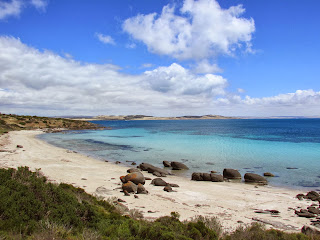We had a late start to this
morning but eventually went into the Port Lincoln information centre and picked
up some tips on where to go. The first
thing they suggested was to head to the marina as there was a whole bunch of
prawning boats coming in to unload their catch – so this is where we first
headed. There were a stack of boats that
had just pulled in and I couldn’t believe the number of boxes being pulled from
each boat and stacked onto pallets. We
asked a few questions, and the first boat that we watched had approximately 6
tonne of prawns to unload. Even more
amazing is that not only did they catch the prawns out at sea but they also
cook and box them out there. Apparently,
about half of them get sent to major cities in Australia and the other half
gets exported to around the world. Even
bigger than prawning here in “Lincoln”, as it’s affectionately known, is the
tuna business and it is primarily due to this huge industry, that South
Australia has the most millionaires per capita – pretty amazing! Two of these men who have had great fortune
in the tuna business are Dean Lukin (gold medal Olympian) and Tony Santic
(Makybe Diva owner). We then drove
nearby to the Fresh Fish Place to taste some of the local produce, Josh
sampling the seafood basket and I had a massive king prawn wrap. We now had the energy to take on Coffin Bay
National Park which was about a half hour drive away. On our way into the town of Coffin Bay we sighted
the oyster farms… so many of them!
Inside the park we spotted a few emus and bob tail lizards as well as
the natural beauty of many beaches and bays such as Avoid Bay and Yangie Bay. Again the water was crystal clear and an
amazing sparkling blue, the cliffs were rugged and light in colour and the I
never tire of seeing the wildlife. Our
last stop of the afternoon was at Pure Coffin Bay Oysters. They do run a quick tour here at certain
times but we’d obviously not turned up at the right time. That didn’t bother Josh though… he waltzed on
down into the shed with family in tow and asked for a dozen freshly shucked
oysters – and in the process got asking questions about the oysters and the
set-up that we’d just walked into, so we managed to get the free tour. There were hundreds of baskets everywhere in
which the oysters live and grow, it’s amazing just how many oysters they pull
out of the water each day. We were
offered to taste a few before actually paying for our dozen to take home – they
were big, juicy and oh so fresh being just 3 hours out of the water.
The following day we did the
other national park, obviously named Lincoln National Park but we had also
decided to do the Whaler’s Way drive.
This meant that before heading off to the park, we had to go to the
information centre and pay fees and pick up a key as the Whaler’s Way is
actually a drive through a large parcel of private property. Ready to go we drove in and headed straight
to Stamford Hill. We decided to climb
this hill just as Matthew Flinders did in February 1802 whilst he
circumnavigated Australia. His crew was
desperate for fresh water supplies and therefore pulled into a nearby bay
(after losing 8 men overboard in seas nearby) and climbed this same hill,
Stamford Hill, to survey the area for fresh water. It was not as big as some of the previous
mountains we’ve climbed but it felt quite special for these reasons. The hundreds of flies which were bothering us
on our walk up were really annoying, being attracted mostly to Josh but I did
end up with one in my mouth and promptly spat it out – yuk! We reached the top where there is a monument
commemorating Matthew Flinders’ voyage and just sat and reflected a while. We had a great view of Boston Bay, Port
Lincoln and the national park from up here.
We next drove around past Spalding Cove and out to Donington Beach,
again a spectacular colour and beautiful coastline. Upon leaving the park we made our way to
Whaler’s Way, south west of Port Lincoln.
There is an old shack as you unlock the gate and enter the property and
a reminder of the whaling industry as you drive in, a big black blubber melting
pot similar to that used by witches. In
the 1830s, the whales would be sighted from the large headlands in the area and
boats would give chase, harpoon then tow the whales back to shore for flensing
(cutting up). The blubber would be
boiled to the valuable oil and the whalebone was also very sought after to use
in the making of umbrellas and corsets.
Some of the special places we pulled in to view included the fur seal
lookout, Osprey Nest, Cape Carnot (S.A.’s oldest rock, estimated to be over
2,600 million years old), Theakstone Crevasse (which is an amazing crevasse or
fault fracture in the cliff and has about 10m high walls) and the most
spectacular being Whaleman’s Grotto and the caves nearby. We had a lot of fun climbing around the
grotto and exploring the rock pools and overhanging caves before retreating to
the car and making one last stop at the “sinkhole”, appropriately names due to
the massive hole in the track. Again we
spotted some wildlife throughout the park like kangaroos and lizards and were
very careful not to run anything down.
It was a big day which was gladly followed by a quiet night…






















































No comments:
Post a Comment